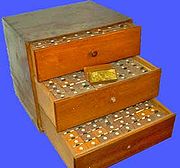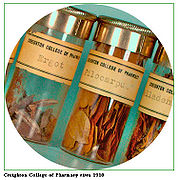
Crude medicine
Encyclopedia
Crude medicine (also known as crude drug in the Chinese materia medica) are bulk drugs from the Chinese materia medica basic processing and treatment.
 A crude drug is any naturally occurring, unrefined substance derived from organic
A crude drug is any naturally occurring, unrefined substance derived from organic
or inorganic sources such as plant, animal, bacteria, organs or whole organisms intended for use in the diagnosis
, cure
, mitigation, treatment
, or prevention of disease in man or other animals.
Crude drugs are unrefined medications in their raw or natural forms. Prior to the 1950s, every pharmacy student learned about crude drugs in pharmacognosy
class. Pharmacognosy is the study of the proper horticulture
, harvesting and uses of the raw medications found in nature.
Raising, harvesting and selling crude drugs was how many large pharmaceutical companies started out. Companies such as Eli Lilly and Company
sold crude drugs to pharmacists to save them time and money, but the early pharmacy graduate would know how to raise their own crude drugs if need be.
community kept knowledge about the medicinal properties of various plants, molds, fungi, yeasts, bacteria, minerals and animals. This drug knowledge would include vast amounts of information like what time of the year to look for specimens, where to look, and what part of the plant to use or how to grind a mineral.
 As cultures developed in specialization
As cultures developed in specialization
, a person would take on the combined role of physician, pharmacist and priest or minister. These specialized people would be in charge of the community’s physical, mental, emotional and spiritual health.
In English these are often called "medicine men" or shaman. The word shaman comes from Manchu
, and is "the only commonly used English word that is a loan from this language". The shaman would use various items from nature to produce a mixture that would be burned, applied, manipulated or ingested in some fashion to help relieve the symptoms the ailing patient.
Eventually, the use of crude drugs reach a zenith in the early 1900s and eventually gave way to the use of purified active ingredients from the natural source. Currently the use and exploration of crude drugs has again gained prominence in the medical community. The realization that many completely unknown substances are yet to be discovered from crude drugs has created a new interest in pharmacognosy and has led to many medical breakthroughs.
In 1907, the Pure Food and Drug Act
was implemented and standardization of crude drugs took place. Often the USP
would specify what percentage of active ingredient was needed to claim a crude drug met USP standards.
An example of standardization would be as follows (from the United States Pharmacopeia
):
Overview

Organic compound
An organic compound is any member of a large class of gaseous, liquid, or solid chemical compounds whose molecules contain carbon. For historical reasons discussed below, a few types of carbon-containing compounds such as carbides, carbonates, simple oxides of carbon, and cyanides, as well as the...
or inorganic sources such as plant, animal, bacteria, organs or whole organisms intended for use in the diagnosis
Diagnosis
Diagnosis is the identification of the nature and cause of anything. Diagnosis is used in many different disciplines with variations in the use of logics, analytics, and experience to determine the cause and effect relationships...
, cure
Cure
A cure is a completely effective treatment for a disease.The Cure is an English rock band.Cure, or similar, may also refer to:-Film and television:* The Cure , a short film starring Charlie Chaplin...
, mitigation, treatment
Therapy
This is a list of types of therapy .* Adventure therapy* Animal-assisted therapy* Aquatic therapy* Aromatherapy* Art and dementia* Art therapy* Authentic Movement* Behavioral therapy* Bibliotherapy* Buteyko Method* Chemotherapy...
, or prevention of disease in man or other animals.
Crude drugs are unrefined medications in their raw or natural forms. Prior to the 1950s, every pharmacy student learned about crude drugs in pharmacognosy
Pharmacognosy
Pharmacognosy is the study of medicines derived from natural sources. The American Society of Pharmacognosy defines pharmacognosy as "the study of the physical, chemical, biochemical and biological properties of drugs, drug substances or potential drugs or drug substances of natural origin as well...
class. Pharmacognosy is the study of the proper horticulture
Horticulture
Horticulture is the industry and science of plant cultivation including the process of preparing soil for the planting of seeds, tubers, or cuttings. Horticulturists work and conduct research in the disciplines of plant propagation and cultivation, crop production, plant breeding and genetic...
, harvesting and uses of the raw medications found in nature.
Raising, harvesting and selling crude drugs was how many large pharmaceutical companies started out. Companies such as Eli Lilly and Company
Eli Lilly and Company
Eli Lilly and Company is a global pharmaceutical company. Eli Lilly's global headquarters is located in Indianapolis, Indiana, in the United States...
sold crude drugs to pharmacists to save them time and money, but the early pharmacy graduate would know how to raise their own crude drugs if need be.
History
In times past, the hunter-gathererHunter-gatherer
A hunter-gatherer or forage society is one in which most or all food is obtained from wild plants and animals, in contrast to agricultural societies which rely mainly on domesticated species. Hunting and gathering was the ancestral subsistence mode of Homo, and all modern humans were...
community kept knowledge about the medicinal properties of various plants, molds, fungi, yeasts, bacteria, minerals and animals. This drug knowledge would include vast amounts of information like what time of the year to look for specimens, where to look, and what part of the plant to use or how to grind a mineral.

Division of labour
Division of labour is the specialisation of cooperative labour in specific, circumscribed tasks and likeroles. Historically an increasingly complex division of labour is closely associated with the growth of total output and trade, the rise of capitalism, and of the complexity of industrialisation...
, a person would take on the combined role of physician, pharmacist and priest or minister. These specialized people would be in charge of the community’s physical, mental, emotional and spiritual health.
In English these are often called "medicine men" or shaman. The word shaman comes from Manchu
Manchu language
Manchu is a Tungusic endangered language spoken in Northeast China; it used to be the language of the Manchu, though now most Manchus speak Mandarin Chinese and there are fewer than 70 native speakers of Manchu out of a total of nearly 10 million ethnic Manchus...
, and is "the only commonly used English word that is a loan from this language". The shaman would use various items from nature to produce a mixture that would be burned, applied, manipulated or ingested in some fashion to help relieve the symptoms the ailing patient.
Eventually, the use of crude drugs reach a zenith in the early 1900s and eventually gave way to the use of purified active ingredients from the natural source. Currently the use and exploration of crude drugs has again gained prominence in the medical community. The realization that many completely unknown substances are yet to be discovered from crude drugs has created a new interest in pharmacognosy and has led to many medical breakthroughs.
In 1907, the Pure Food and Drug Act
Pure Food and Drug Act
The Pure Food and Drug Act of June 30, 1906, is a United States federal law that provided federal inspection of meat products and forbade the manufacture, sale, or transportation of adulterated food products and poisonous patent medicines...
was implemented and standardization of crude drugs took place. Often the USP
United States Pharmacopeia
The United States Pharmacopeia is the official pharmacopeia of the United States, published dually with the National Formulary as the USP-NF. The United States Pharmacopeial Convention is the nonprofit organization that owns the trademark and copyright to the USP-NF and publishes it every year...
would specify what percentage of active ingredient was needed to claim a crude drug met USP standards.
An example of standardization would be as follows (from the United States Pharmacopeia
United States Pharmacopeia
The United States Pharmacopeia is the official pharmacopeia of the United States, published dually with the National Formulary as the USP-NF. The United States Pharmacopeial Convention is the nonprofit organization that owns the trademark and copyright to the USP-NF and publishes it every year...
):
OpiumOpiumOpium is the dried latex obtained from the opium poppy . Opium contains up to 12% morphine, an alkaloid, which is frequently processed chemically to produce heroin for the illegal drug trade. The latex also includes codeine and non-narcotic alkaloids such as papaverine, thebaine and noscapine...
is the air-dried milky exudate obtained by incising the unripe capsules of Papaver somniferum Linne or its variety album De Candolle (Fam. Papaveraceae).
Opium in its normal air-dried condition yields not less than 9.5 percent of anhydrous morphineMorphineMorphine is a potent opiate analgesic medication and is considered to be the prototypical opioid. It was first isolated in 1804 by Friedrich Sertürner, first distributed by same in 1817, and first commercially sold by Merck in 1827, which at the time was a single small chemists' shop. It was more...
.
See also
- Traditional Chinese medicineTraditional Chinese medicineTraditional Chinese Medicine refers to a broad range of medicine practices sharing common theoretical concepts which have been developed in China and are based on a tradition of more than 2,000 years, including various forms of herbal medicine, acupuncture, massage , exercise , and dietary therapy...
- Chinese herbologyChinese herbologyChinese Herbology is the theory of Traditional Chinese herbal therapy, which accounts for the majority of treatments in Traditional Chinese medicine ....
- Chinese herbs
- Chinese patent medicineChinese patent medicineChinese patent medicine are herbal medicines in Traditional Chinese medicine. Many kinds of Chinese patent medicines are still sold today.-Description:...

